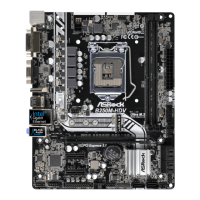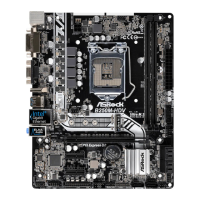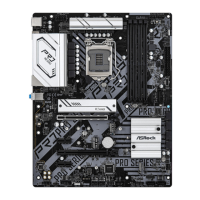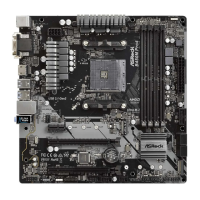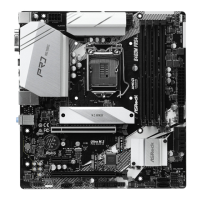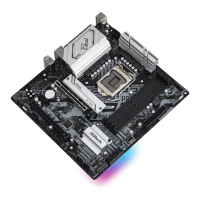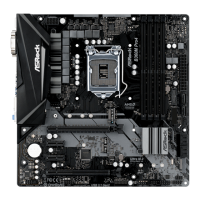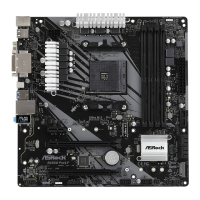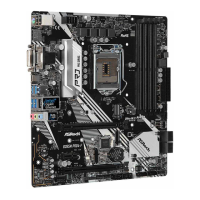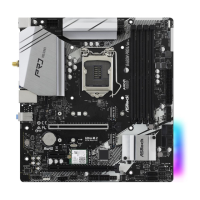Do you have a question about the ASROCK B250M PRO4 and is the answer not in the manual?
Lists all items included in the motherboard box.
Details the platform, CPU, chipset, memory, expansion slots, graphics, audio, and LAN specs.
Diagram and numbering of motherboard components and connectors.
Diagram and description of rear panel connectors and their functions.
Step-by-step guide on how to install the CPU into the socket.
Instructions for mounting the CPU cooler assembly.
Guide for installing RAM modules, including dual channel configuration.
Details on available PCI and PCIe slots and their configurations.
Explains various system panel, SATA, USB, and fan headers on the motherboard.
Instructions for setting up multiple graphics cards using AMD CrossFireX.
Steps to physically install two graphics cards for CrossFireX.
Guide to install drivers and configure AMD CrossFireX.
Instructions for installing M.2 SSDs, including nut locations and types.
How to install drivers and utilities from the support CD.
Guide to ASRock's software for updating drivers and apps.
Explanation of the ASRock APP Shop interface elements.
How to find, install, and manage applications via the APP Shop.
How to update BIOS and drivers using the APP Shop.
Configuration options for the ASRock Live Update & APP Shop.
Guide to prepare installation media for Windows 7 with specific USB drivers.
Explains how to enter and navigate the UEFI setup utility.
Overview of the default EZ Mode dashboard for system status.
Introduction to the advanced BIOS settings and navigation.
Lists the main menu options in the UEFI setup utility.
Explains keyboard shortcuts for navigating the UEFI setup.
Displays system overview and collection of BIOS items.
Settings for overclocking CPU, memory, and voltages.
Access to detailed CPU, Chipset, Storage, IO, ACPI, USB, and Trusted Computing configurations.
Settings for processor cores, C-states, thermal throttling, and virtualization.
Settings for graphics adapter, PCIe speeds, ASPM, and memory allocation.
Configuration for SATA controllers, speed, power management, and SMART.
Settings for Serial, Parallel, and Device modes.
Power management settings like Suspend to RAM and wake-up events.
Settings for Legacy USB support, PS/2 simulator, and XHCI hand-off.
Configuration for BIOS support for security devices.
Access to UEFI Tech Service and Easy Driver Installer.
Monitoring system hardware status, temperatures, fan speeds, and voltages.
Setting supervisor/user passwords and secure boot options.
Configuring boot options, priorities, and boot behavior.
Options for saving changes, discarding changes, and loading defaults.
Lists all items included in the motherboard box.
Details the platform, CPU, chipset, memory, expansion slots, graphics, audio, and LAN specs.
Diagram and numbering of motherboard components and connectors.
Diagram and description of rear panel connectors and their functions.
Step-by-step guide on how to install the CPU into the socket.
Instructions for mounting the CPU cooler assembly.
Guide for installing RAM modules, including dual channel configuration.
Details on available PCI and PCIe slots and their configurations.
Explains various system panel, SATA, USB, and fan headers on the motherboard.
Instructions for setting up multiple graphics cards using AMD CrossFireX.
Steps to physically install two graphics cards for CrossFireX.
Guide to install drivers and configure AMD CrossFireX.
Instructions for installing M.2 SSDs, including nut locations and types.
How to install drivers and utilities from the support CD.
Guide to ASRock's software for updating drivers and apps.
Explanation of the ASRock APP Shop interface elements.
How to find, install, and manage applications via the APP Shop.
How to update BIOS and drivers using the APP Shop.
Configuration options for the ASRock Live Update & APP Shop.
Guide to prepare installation media for Windows 7 with specific USB drivers.
Explains how to enter and navigate the UEFI setup utility.
Overview of the default EZ Mode dashboard for system status.
Introduction to the advanced BIOS settings and navigation.
Lists the main menu options in the UEFI setup utility.
Explains keyboard shortcuts for navigating the UEFI setup.
Displays system overview and collection of BIOS items.
Settings for overclocking CPU, memory, and voltages.
Access to detailed CPU, Chipset, Storage, IO, ACPI, USB, and Trusted Computing configurations.
Settings for processor cores, C-states, thermal throttling, and virtualization.
Settings for graphics adapter, PCIe speeds, ASPM, and memory allocation.
Configuration for SATA controllers, speed, power management, and SMART.
Settings for Serial, Parallel, and Device modes.
Power management settings like Suspend to RAM and wake-up events.
Settings for Legacy USB support, PS/2 simulator, and XHCI hand-off.
Configuration for BIOS support for security devices.
Access to UEFI Tech Service and Easy Driver Installer.
Monitoring system hardware status, temperatures, fan speeds, and voltages.
Setting supervisor/user passwords and secure boot options.
Configuring boot options, priorities, and boot behavior.
Options for saving changes, discarding changes, and loading defaults.
| ECC | Yes |
|---|---|
| Memory channels | Dual-channel |
| Memory slots type | DIMM |
| Number of memory slots | 4 |
| Supported memory types | DDR4-SDRAM |
| Maximum internal memory | 64 GB |
| Supported memory clock speeds | 2133, 2400 MHz |
| Supported memory module capacities | 4GB, 8GB, 16GB |
| Audio chip | Realtek ALC892 |
| Cooling type | Passive |
| Certification | FCC, CE, WHQL, ErP/EuP |
| Component for | PC |
| Power source type | ATX |
| Motherboard chipset | Intel® B250 |
| PC health monitoring | CPU, FAN, Temperature, Voltage |
| Audio output channels | 7.1 channels |
| Motherboard form factor | micro ATX |
| Motherboard chipset family | Intel |
| Processor socket | LGA 1151 (Socket H4) |
| Compatible processor series | Intel Celeron, Intel Pentium |
| Intel® Core i3/i5/i7/i9 series | i3-6xxx, i5-6xxx, i7-6xxx |
| Maximum number of SMP processors | 1 |
| DirectX version | 12.0 |
| Maximum resolution | 4096 x 2160 pixels |
| Parallel processing technology support | 2-Way CrossFireX, 4-Way CrossFireX |
| PCI Express x16 (Gen 3.x) slots | 2 |
| Number of SATA III connectors | 6 |
| USB 3.2 Gen 2 (3.1 Gen 2) connectors | 0 |
| BIOS type | UEFI AMI |
| ACPI version | 6.0 |
| BIOS memory size | 128 Mbit |
| USB 2.0 ports quantity | USB 2.0 ports have a data transmission speed of 480 Mbps, and are backwards compatible with USB 1.1 ports. You can connect all kinds of peripheral devices to them. |
| USB 3.2 Gen 1 (3.1 Gen 1) Type-A ports quantity | 3 |
| LAN controller | Intel® I219 |
| Ethernet interface type | Gigabit Ethernet |
| Cables included | SATA |
| Bundled software | ASRock APP Charger ASRock XFast LAN ASRock EZ Mode ASRock Full HD UEFI ASRock My Favorites in UEFI ASRock Instant Flash ASRock Internet Flash ASRock Crashless BIOS ASRock UEFI Tech Service |
| Harmonized System (HS) code | 84733020 |
| Width | 244 mm |
|---|
